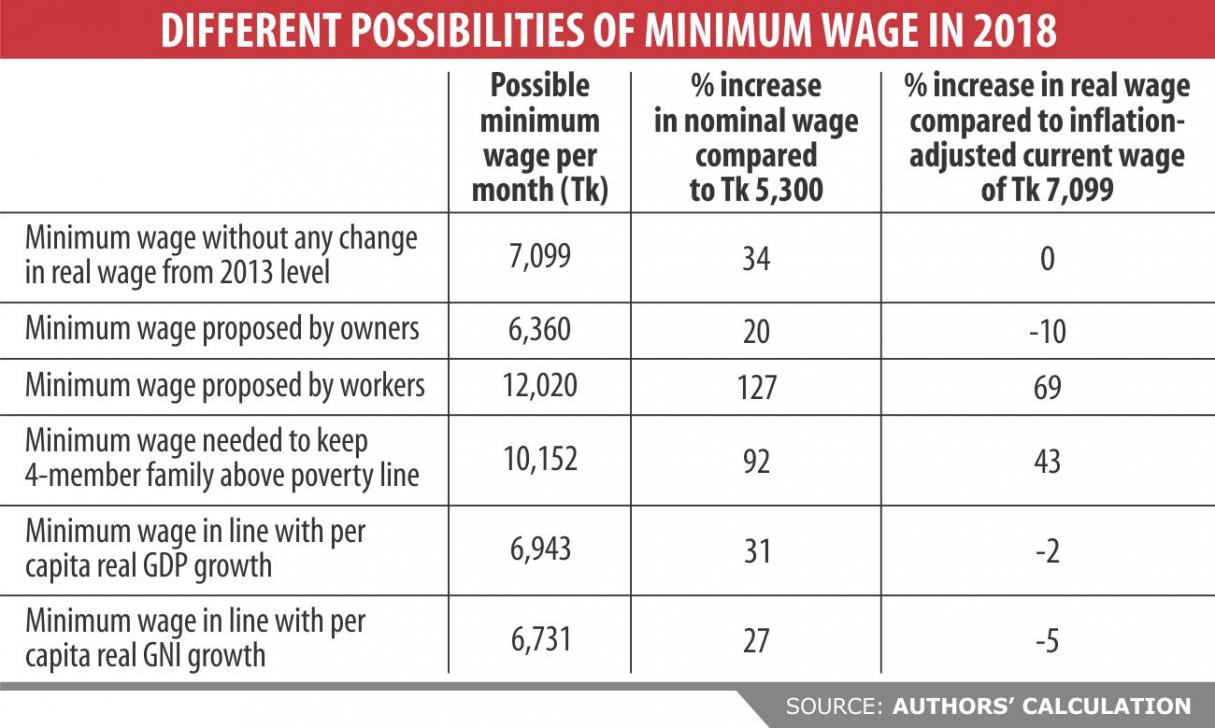How minimum should be the minimum wage of garment workers?

The minimum wage board is working on a new minimum pay for garment workers.
In a meeting few days ago, the representative of the garment factory owners proposed raising the minimum wage by 20 percent to Tk 6,360.
Obviously, mathematical calculation would suggest this to be a 20 percent increase if there were no inflation. But between 2013 and 2018, the prices of essentials have gone up, which has reduced the purchasing power of workers.
So, after adjusting for inflation, it would mean the owners are proposing only a 10 percent increase in wages -- and not 20 percent. A reduction in real wage or decline in the purchasing power of workers is not acceptable.
In contrast, the representative of workers to the wage board has proposed a new minimum wage of Tk 12,020. This rate refers to 127 percent growth in nominal wage and 69 percent growth in real wage. This is much higher than the 37 percent growth of real wage from 2010 to 2013. Now let us explore various possibilities of a new minimum wage.
With a positive rate of inflation, a certain amount of money loses its purchasing power over time. As the overall price level keeps accelerating, one requires a higher amount of money every year in order to avail the same, previous year's consumption bundle.
For example, if we adjust for inflation, the consumption bundle that could be purchased at the minimum wage in 2013 (e.g. Tk 5,300) now costs Tk 7,099 in 2018. Thus, just to keep the purchasing power or real wage the same as in 2013, the minimum wage should be increased to Tk 7,099.
This increase would mean a 34 percent increase in nominal wage, but a zero percent increase in real wage. In other words, this increase would add nothing to a worker's purchasing power.
It is very much expected that the revised minimum wage rate will not only compensate for inflation but also raise workers' purchasing power. In short, their real wage should rise.
In fact, the latest revision of minimum wage (from Tk 3,000 in 2010 to Tk 5,300 in 2013) was associated with a 37 percent increase in real wage. In that vein, in 2018 the workers should expect a minimum wage of Tk 9,725.
One way to estimate the minimum wage rate is to look at the poverty line income, which is required to maintain a minimum level of living standard. This approach is also called the cost of basic need approach.
The Household Income and Expenditure Survey 2016 said an individual requires a monthly income of Tk 2,268 to live just above the poverty line. Therefore, a four-member family, with only one income-earner, would require a monthly income of Tk 9,072 in 2016.
By considering 5 percent inflation in the last two years, this wage according to the cost of basic needs should be Tk 10,152 in 2018. However, if there is more than one earner in the family the required income to meet the cost of basic needs would be smaller.
Another useful principle in setting the minimum wage rate could be to increase the wage rate by the same percentage as the increase in national income.
The per capita real GDP and the per capita real GNP increased 31 percent and 27 percent respectively from 2013 to 2018, as per the latest national accounts statistics of the Bangladesh Bureau of Statistics.
The 31 percent and 27 percent increase in the wage rate would be equivalent to the increase in wages to Tk 6,943 and Tk 6,731 respectively from its current value of Tk 5,300.
However, considering the inflation adjusted current real wage rate of Tk 9,077, these per capita GDP or per capita GNI-induced minimum wage would mean a decrease in real wage. The minimum wage that lessens the real wage from the current level is not really acceptable.
Thus, we are left with the options of a minimum wage that must be more than Tk 7,099, as any wage below this level would mean a decline in the real wage of workers.
In terms of purchasing power parity (PPP) dollars, this amount stands at $229. As workers deserve growth in their real income, the other possibilities are Tk 9,725 ($314), Tk 10,152 ($327), or according to the proposal of the workers' representative Tk 12,020 ($388).
Obviously the main concern with any increase in wage is the possible impact on the international competitive position of Bangladesh. If we compare the PPP wage of Bangladesh with some of the competitors, we find that it is still lower than any of them though the gap would decline.
We also have to understand that the garment industry of Bangladesh is going through a transition after the Rana Plaza tragedy and the cost of compliance has increased to a large extent.
A high increase in the minimum wage could put extra pressure on the owners and the businesses. Therefore, the Minimum Wage Board should consider all these possibilities before finalising the figure.
